Understanding Qualcomm's Snapdragon 810: Performance Preview
by Joshua Ho & Andrei Frumusanu on February 12, 2015 9:00 AM EST- Posted in
- SoCs
- Qualcomm
- Mobile
- Gobi
- Snapdragon 810
GPU Performance
Last but certainly not least, we have GPU performance. As we mentioned earlier, the Snapdragon 810 introduces Qualcomm's Adreno 430, the latest member of the Adreno 400 GPU family. Qualcomm's own performance estimates call for a 30% increase over Adreno 420, with a final GPU clock of 600MHz being identical to the Snapdragon 805's (Adreno 420) own GPU clock speed.
From an architectural standpoint Adreno continues to be something of a black box for us. Other than being a modern OpenGL ES 3.1/AEP design, we don't know too much about how the GPU is laid out, and Qualcomm's current legal battle with NVIDIA likely not helping matters. In any case, Qualcomm has indicated that Adreno 430 is not just a simple extension of Adreno 420, so we may be looking at an architectural change such as wider shader blocks.
For today's benchmarks, as we mentioned before we only had a limited amount of time with the Snapdragon 810 and had issues with BaseMark X. We've had to pare down our GPU benchmarks to just 3DMark 1.2 and GFXBench 3.0. Once we get final hardware in, we will be able to run a wider array of graphics benchmarks on Snapdragon 810.
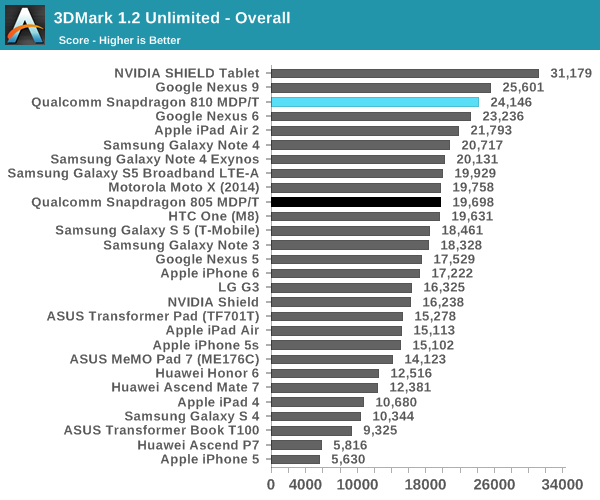
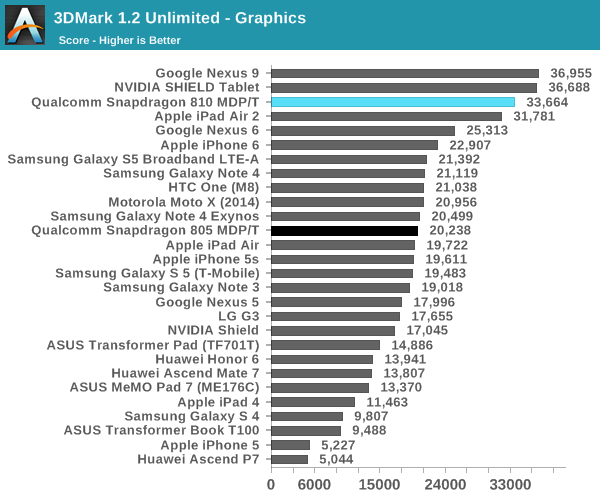
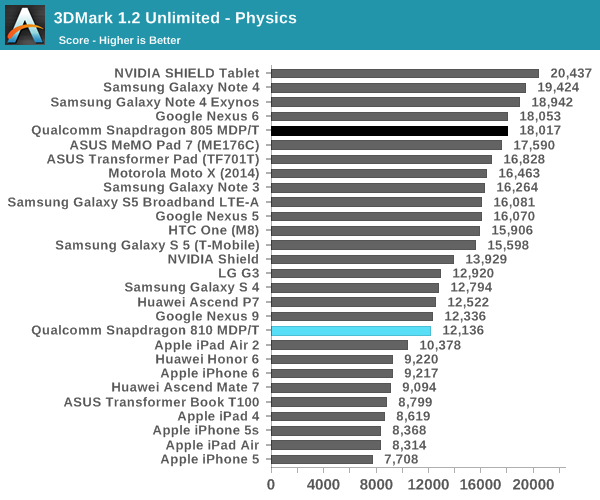
Starting off with 3DMark, compared to the Snapdragon 805 reference platform the actual graphics performance advantage is even greater than 30%, coming in at closer to 65%. However since drivers play a big role in this, a more recent 805 platform like the Nexus 6 may be a better comparison point, in which case the gains are 33%, just a hair over Qualcomm's own baseline performance estimate. We also find that Snapdragon 810 oddly struggles at physics performance here, underperforming Snapdragon 805 devices, something the Exynos 5433 didn't have trouble with. As a result overall performance is only slightly improved over the Nexus 6.
Continuing with GFXBench, we look at more pure GPU loads. One has to take note that the MDP/T employs a 4K screen resolution, and the on-screen results will likely suffer from that.

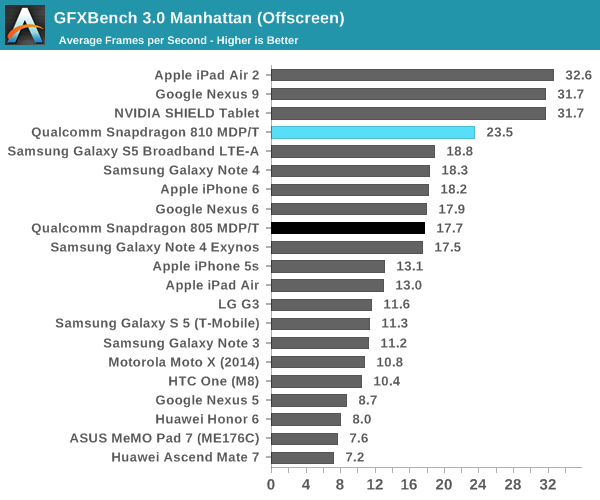
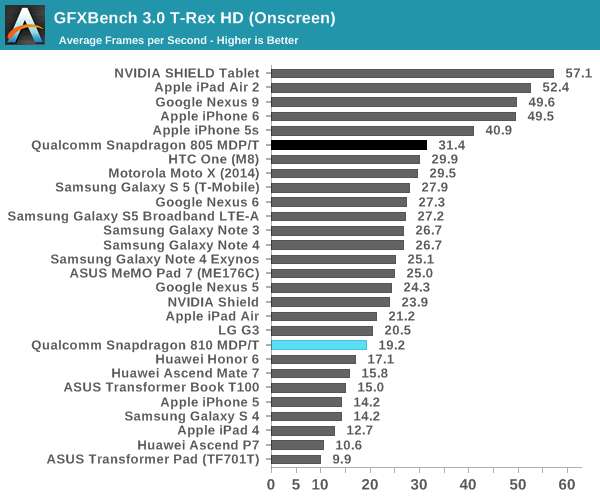
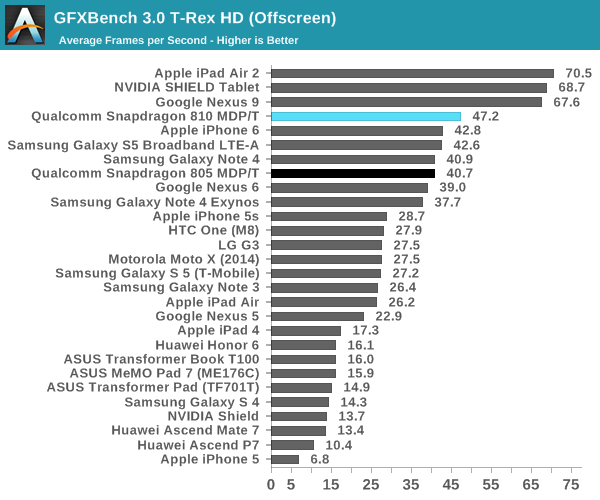
Under GFXBench 3.0's full rendering tests of Manhattan and T-Rex, the Snapdragon 810 continues to show considerable performance gains over the Snapdragon 805. Ignoring the onscreen results for now since the Snapdragon 810 reference platform runs at such a high resolution, offscreen results show the 810 outperforming the 805 by 33% in Manhattan and 16% in T-Rex. The former is again well in-line with Qualcomm's performance estimate, wile the older T-Rex benchmark doesn't show the same gains, possibly indicating that Adreno 430's biggest gains are going to come from shader-bound scenarios.
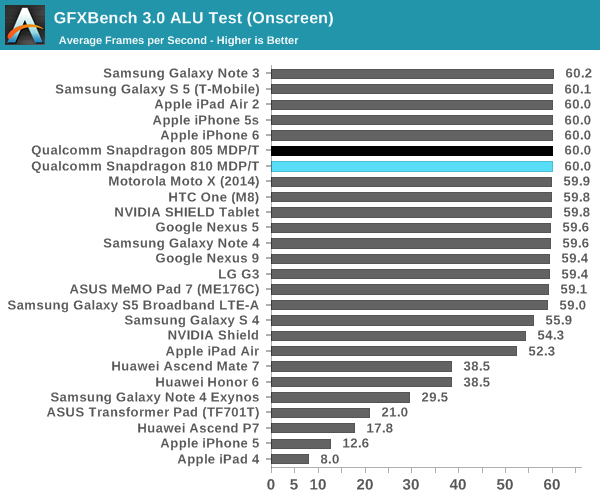
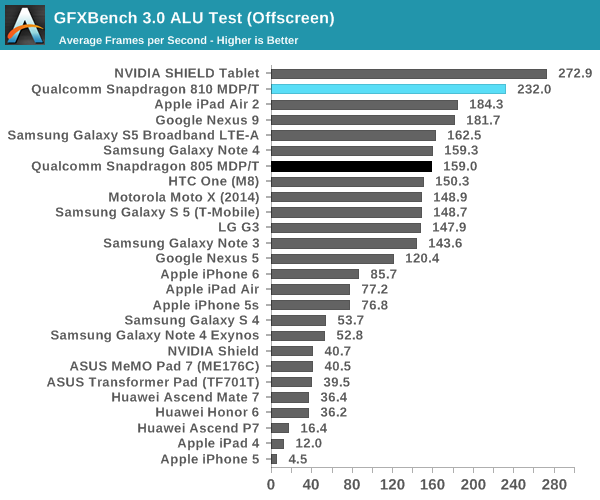

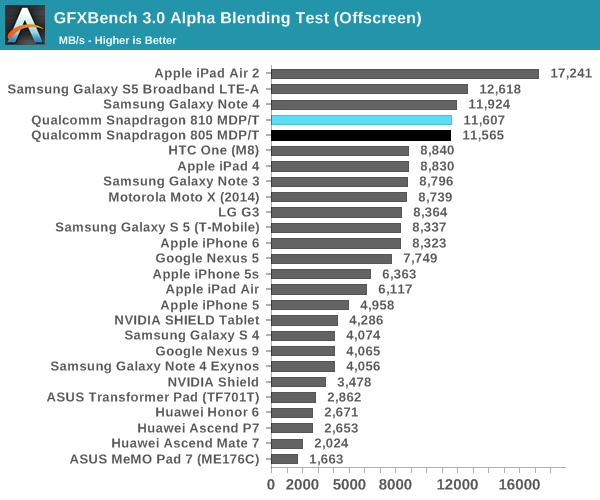
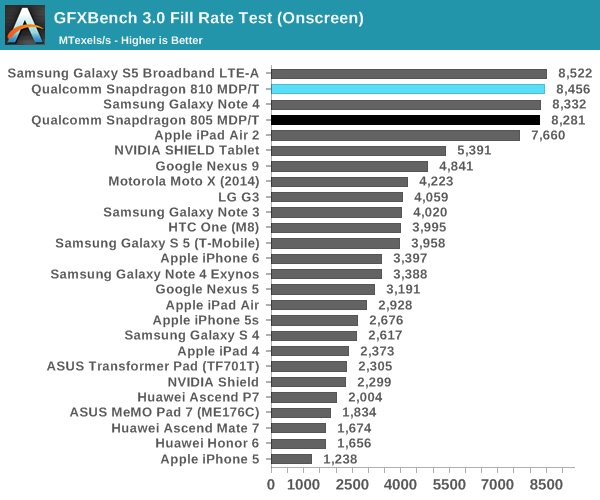
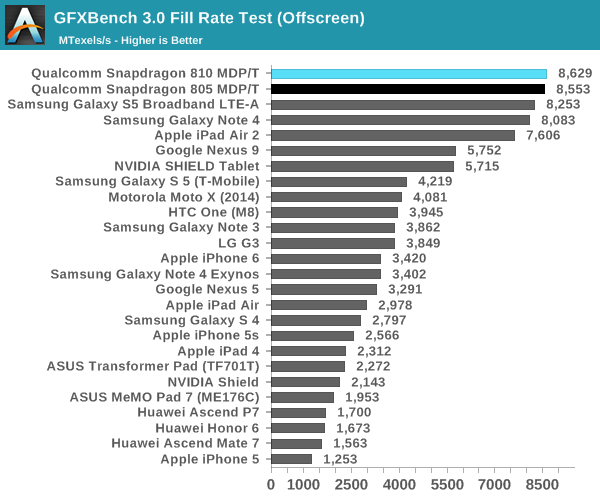
Meanwhile GFXBench's synthetic tests continue to put Adreno 430 and the Snapdragon 810 in a good light. ALU performance in particular is showing very large gains - 46% better than the Snapdragon 805 and Adreno 420 - while our blending and fillrate tests show almost no gain over Snapdragon 805. This adds further credence to our theory that Qualcomm has widened or otherwise improved Adreno's shader blocks for 430, as other elements of the GPU are not showing significant performance changes.
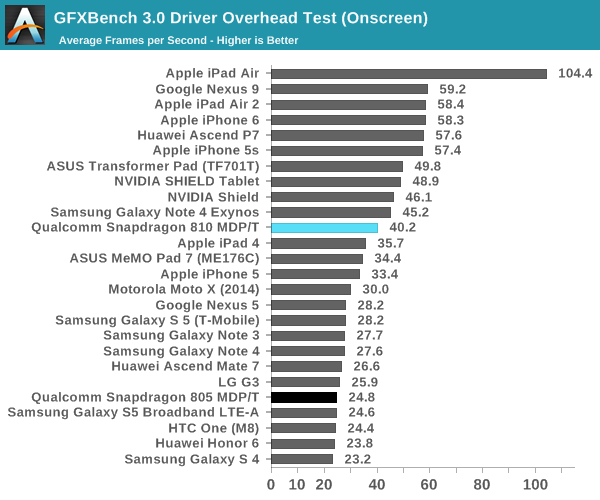
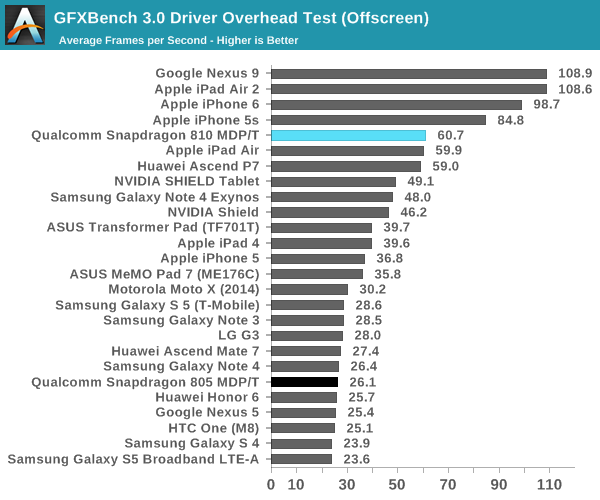
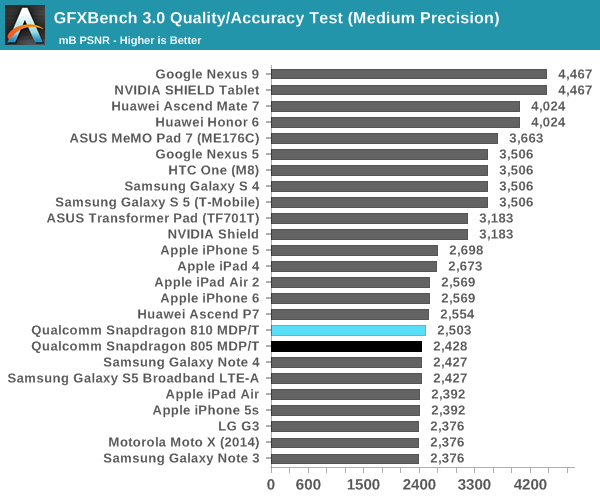

Finally, GFXBench's driver overhead and accuracy tests are more or less what we would expect for Snapdragon 810. In the case of driver overhead, a combination of newer drivers and a much faster CPU have reduced the CPU cost of driver overhead. Meanwhile with the underlying GPU architecture being unchanged, there are no material changes to quality/accuracy.
Overall then the performance gains for the Adreno 430 and Snapdragon 810 seem to be almost exclusively focused on shader performance, but in those cases where rendering workloads are shader bound, Qualcomm's 30% estimate is on the mark. Real-word performance gains meanwhile are going to depend on the nature of the workload; games and applications that are similarly shader-bound should see good performance gains, while anything that's bottlenecked by pixel throughput, texturing, or front-end performance will see much smaller gains. Thankfully for Qualcomm most high-end workloads are indeed shader bound, and this is especially the case when pushing high resolutions, as Qualcomm is trying to do with their 4K initiative for Snapdragon 810. However in the case of 4K, while Adreno 430 offers improved performance it's still slow enough that it's going to struggle to render any kind of decently complex content at that resolution.
As for Adreno 430 versus the competition, Qualcomm has narrowed much of the gap between themselves and NVIDIA/Apple, but they haven't closed it. Apple's Imagination GX6850 and NVIDIA's K1 GPUs continue to hold a performance advantage, particularly in GFXBench's Manhattan and T-Rex full rendering tests. Both Apple and NVIDIA invested significant die space in graphics, and while we don't know how much Qualcomm has invested in Adreno 430 with Snapdragon 810, it's safe to say right now that they would need to invest even more if they want to beat the graphics performance of NVIDIA and Apple's tablet SoCs.










119 Comments
View All Comments
JoshHo - Thursday, February 12, 2015 - link
Comparing the Snapdragon 810 to the Exynos 5433 wouldn't be of much value as the S810 won't be competing with the Exynos 5433 in flagship 2015 devices. We hope to make a valid comparison to an Exynos SoC in the near future.warreo - Thursday, February 12, 2015 - link
I disagree. This article is already primarily a comparison of S810 and S805, which like the Exynos will obviously not be competing for flagship 2015 devices. Does that make the comparison invalid? No, it's just a matter of context. People know that Exynos 5433 is an older SoC, but it's still interesting to see how S810 compares to it, just like it is interesting to see how it compares to S805.In reading this article the most interesting takeaways that I got are that on the CPU side, S810 is in a dead heat with Exynos (or barely outperforms it), and on the GPU side, there was a more substantial outperformance (call it 20-25%) vs. Exynos. The sad thing is that I had to draw that conclusion myself, because it was barely addressed in the article.
As an aside, can someone please learn me on how this performance is considered good when Exynos 7420 is right around the corner? Am I missing something?
Andrei Frumusanu - Thursday, February 12, 2015 - link
The vast majority of users will want to compare performance to the S805, seeing as the 5433 is only found in one variant of the Note 4 and probably won't bee seeing any other implementation.As for your last point, we just can't comment on performance of unreleased products.
warreo - Thursday, February 12, 2015 - link
Unfortunately, I still disagree. While most people will never use the 5433 because it is limited to the Note 4, it is still a relevant comparison because the S6 will use the 7420, which is the next iteration of the 5433. Lest we forget, there are (likely) millions of people who will buy or consider buying the S6, making the comparison against 5433 an early preview of 7420 vs. S810 which I'm willing to bet is HIGHLY interesting to readers of this site.No direct comments on the unreleased 7420 would be necessary, just a more indepth discussion on how the S810 fares against 5433 would be helpful and let readers extrapolate to 7420 themselves. The reality is, the data and benchmarks are all there, I'm just a bit mystified why it is apparently not worth the effort to add the % difference into the table and discuss those results more in the text of the article.
I'll make this my last comment on the matter as you've at least shown you've thought about the matter and had a reason as to why you didn't really discuss Exynos. I remain cynical as to whether this is a good reason (or even the true reason), but I do at least appreciate the responses. I hope you'll take my comments in the spirit in which they were given: constructive criticism to improve the quality of the article.
lopri - Thursday, February 12, 2015 - link
Millions of people considering the S6 will want to know how S810 (or rather Exynos 7420) performs compared to S600/S800/S801, because those are the platforms they are currently using. Millions of people also do not have access to the Exynos 5433 Note 4, and will not be upgrading from or to it. It would be akin to comparing some obscure Xeon CPU to widely popular Core i5 CPU.I fully expect there will be a comparison between S810 and whatever else it competes against in due time.
Jumangi - Friday, February 13, 2015 - link
Millions? Let's be real here. 99%+ of the people who go out to buy the next Galaxy phone or any smartphone for that matter won't have the slightest clue of the SoC in the thing.tdslam720 - Thursday, February 12, 2015 - link
Way to miss out on all the hype. Take some hints from Pro Wrestling or UFC. Samsung vs Qualcomm is the hype right now. Exynos vs 810 . You claim people want to see 810 vs 805, no one cares about that. Give us 810 vs Exynos and get tons more ad money while maintaining your credibility. Right now it just looks like Qualcomm is influencing you to play nice.melgross - Thursday, February 12, 2015 - link
You say no one cares about that, but that's just you saying that. Samsung doesn't sell a whole lot of Notes, particularly to the number of devices Qualcomm sells into.tdslam720 - Thursday, February 12, 2015 - link
No but they'll sell millions of S6s which is basically the same chipblzd - Thursday, February 12, 2015 - link
We should care about a CPU in a phone that we will never use? Because the next iteration perhaps we will be able to use? Um no.S800 vs S810 is what I want to know personally.